Variable-frequency drive
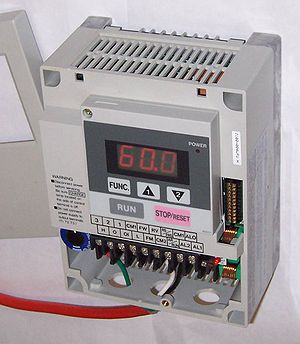 A variable-frequency drive (VFD) is a system for controlling the rotational speed of an alternating current (AC) electric motor by controlling the frequency of the electrical power supplied to the motor. A variable frequency drive is a specific type ofadjustable-speed drive. Variable-frequency drives are also known as adjustable-frequency drives (AFD), variable-speed drives (VSD), AC drives, microdrives or inverter drives. Since the voltage is varied along with frequency, these are sometimes also called VVVF (variable voltage variable frequency) drives.
A variable-frequency drive (VFD) is a system for controlling the rotational speed of an alternating current (AC) electric motor by controlling the frequency of the electrical power supplied to the motor. A variable frequency drive is a specific type ofadjustable-speed drive. Variable-frequency drives are also known as adjustable-frequency drives (AFD), variable-speed drives (VSD), AC drives, microdrives or inverter drives. Since the voltage is varied along with frequency, these are sometimes also called VVVF (variable voltage variable frequency) drives.
Variable-frequency drives are widely used. For example, in ventilations systems for large buildings, variable-frequency motors on fans save energy by allowing the volume of air moved to match the system demand. Variable frequency drives are also used on pumps, conveyor and machine tool drives.
Operating principle
The synchronous speed of an AC motor is determined by the frequency of the AC supply and the number of poles in the stator winding, according to the relation:
where
n = Revolutions per minute (rpm)
f = AC power frequency (hertz)
p = Number of poles (an even number)
The constant, 120, is 60 seconds per minute multiplied by 2 poles per pole pair. Sometimes 60 is used as the constant and p is stated as pole pairs rather than poles. By varying the frequency of the voltage applied to the motor, its speed can be changed.
Synchronous motors operate at the synchronous speed determined by the above equation. The speed of an induction motor is slightly less than the synchronous speed.
Example
A 4-pole motor that is connected directly to 60 Hz utility (mains) power would have a synchronous speed of 1,800 rpm:
If the motor is an induction motor, the operating speed at full load will be about 1,750 rpm.
If the motor is connected to a speed controller that provides power at 50 Hz, the synchronous speed would be 1,500 rpm:
VFD types
All VFDs use their output devices (IGBTs, transistors, thyristors) only as switches, turning them only on or off. Attempting to use a linear device such as transistor in its linear mode would be impractical, since power dissipated in the output devices would be about as much as power delivered to the load.
Drives can be classified as:
- Constant voltage
- Constant current
- Cycloconverter
In a constant voltage converter, the intermediate DC link voltage remains approximately constant during each output cycle. In constant current drives, a large inductor is placed between the input rectifier and the output bridge, so the current delivered is nearly constant. A cycloconverter has no input rectifier or DC link and instead connects each output terminal to the appropriate input phase.
The most common type of packaged VF drive is the constant-voltage type, using pulse width modulation to control both the frequency and effective voltage applied to the motor load.
VFD system description
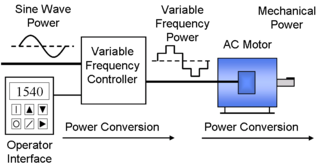 A variable frequency drive system generally consists of an AC motor, a controller and an operator interface.
A variable frequency drive system generally consists of an AC motor, a controller and an operator interface.
VFD motor
The motor used in a VFD system is usually a three-phase induction motor. Some types of single-phase motors can be used, but three-phase motors are usually preferred. Various types of synchronous motors offer advantages in some situations, but induction motors are suitable for most purposes and are generally the most economical choice. Motors that are designed for fixed-speed mains voltage operation are often used, but certain enhancements to the standard motor designs offer higher reliability and better VFD performance.
VFD controller
Variable frequency drive controllers are solid state electronic power conversion devices. The usual design first converts AC input power to DC intermediate power using a rectifier bridge. The DC intermediate power is then converted to quasi-sinusoidal AC power using an inverter switching circuit. The rectifier is usually a three-phase diode bridge, but controlled rectifier circuits are also used. Since incoming power is converted to DC, many units will accept single-phase as well as three-phase input power (acting as a phase converter as well as a speed controller); however the unit must be derated when using single phase input as only part of the rectifier bridge is carrying the connected load.
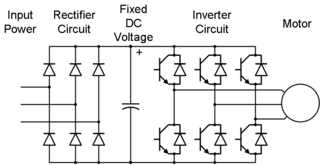 As new types of semiconductor switches have been introduced, these have promptly been applied to inverter circuits at all voltage and current ratings for which suitable devices are available. Introduced in the 1980s, the insulated-gate bipolar transistor(IGBT) became the device used in most VFD inverter circuits in the first decade of the 21st century.
As new types of semiconductor switches have been introduced, these have promptly been applied to inverter circuits at all voltage and current ratings for which suitable devices are available. Introduced in the 1980s, the insulated-gate bipolar transistor(IGBT) became the device used in most VFD inverter circuits in the first decade of the 21st century.
AC motor characteristics require the applied voltage to be proportionally adjusted whenever the frequency is changed in order to deliver the rated torque. For example, if a motor is designed to operate at 460 volts at 60 Hz, the applied voltage must be reduced to 230 volts when the frequency is reduced to 30 Hz. Thus the ratio of volts per hertz must be regulated to a constant value (460/60 = 7.67 V/Hz in this case). For optimum performance, some further voltage adjustment may be necessary especially at low speeds, but constant volts per hertz is the general rule. This ratio can be changed in order to change the torque delivered by the motor.
In addition to this simple volts per hertz control more advanced control methods such as vector control and direct torque control(DTC) exist. These methods adjust the motor voltage in such a way that the magnetic flux and mechanical torque of the motor can be precisely controlled.
The usual method used to achieve variable motor voltage is pulse-width modulation (PWM). With PWM voltage control, the inverter switches are used to construct a quasi-sinusoidal output waveform by a series of narrow voltage pulses with sinusoidally varying pulse durations.
Operation of the motors above rated name plate speed (base speed) is possible, but is limited to conditions that do not require more power than nameplate rating of the motor. This is sometimes called “field weakening” and, for AC motors, means operating at less than rated volts/hertz and above rated name plate speed. Permanent magnet synchronous motors have quite limited field weakening speed range due to the constant magnet flux linkage. Wound rotor synchronous motors and induction motors have much wider speed range. For example, a 100 hp, 460 V, 60 Hz, 1775 RPM (4 pole) induction motor supplied with 460 V, 75 Hz (6.134 V/Hz), would be limited to 60/75 = 80% torque at 125% speed (2218.75 RPM) = 100% power. At higher speeds the induction motor torque has to be limited further due to the lowering of the breakaway torque of the motor. Thus rated power can be typically produced only up to 130…150 % of the rated name plate speed. Wound rotor synchronous motors can be run even higher speeds. In rolling mill drives often 200…300 % of the base speed is used. Naturally the mechanical strength of the rotor and lifetime of the bearings is also limiting the maximum speed of the motor. It is recommended to consult the motor manufacturer if more than 150 % speed is required by the application.
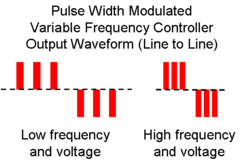 An embedded microprocessor governs the overall operation of the VFD controller. The main microprocessor programming is in firmware that is inaccessible to the VFD user. However, some degree of configuration programming and parameter adjustment is usually provided so that the user can customize the VFD controller to suit specific motor and driven equipment requirements.
An embedded microprocessor governs the overall operation of the VFD controller. The main microprocessor programming is in firmware that is inaccessible to the VFD user. However, some degree of configuration programming and parameter adjustment is usually provided so that the user can customize the VFD controller to suit specific motor and driven equipment requirements.
VFD operator interface
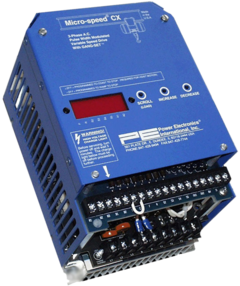 The operator interface, also commonly known as an Human Machine Interface (HMI), provides a means for an operator to start and stop the motor and adjust the operating speed. Additional operator control functions might include reversing and switching between manual speed adjustment and automatic control from an external process control signal. The operator interface often includes an alphanumeric display and/or indication lights and meters to provide information about the operation of the drive. An operator interface keypad and display unit is often provided on the front of the VFD controller as shown in the photograph above. The keypad display can often be cable-connected and mounted a short distance from the VFD controller. Most are also provided with input and output (I/O) terminals for connecting pushbuttons, switches and other operator interface devices or control signals. A serial communications port is also often available to allow the VFD to be configured, adjusted, monitored and controlled using a computer.
The operator interface, also commonly known as an Human Machine Interface (HMI), provides a means for an operator to start and stop the motor and adjust the operating speed. Additional operator control functions might include reversing and switching between manual speed adjustment and automatic control from an external process control signal. The operator interface often includes an alphanumeric display and/or indication lights and meters to provide information about the operation of the drive. An operator interface keypad and display unit is often provided on the front of the VFD controller as shown in the photograph above. The keypad display can often be cable-connected and mounted a short distance from the VFD controller. Most are also provided with input and output (I/O) terminals for connecting pushbuttons, switches and other operator interface devices or control signals. A serial communications port is also often available to allow the VFD to be configured, adjusted, monitored and controlled using a computer.
VFD Operation
When a motor is simply switched to the grid at full voltage, it initially draws at least 300% of its rated current from the mains. As the load accelerates, the available torque usually drops a little and then rises to a peak while the current remains very high until the motor approaches full speed.
On the contrary, when a VFD starts a motor, it initially applies a low frequency and voltage to the motor. The starting frequency is typically 2 Hz or less. Thus starting at such a low frequency avoids the high inrush current that occurs when a motor is started by simply applying the utility (mains) voltage by turning on a switch. After the start of the VFD, the applied frequency and voltage are increased at a controlled rate or ramped up to accelerate the load without drawing excessive current. This starting method typically allows a motor to develop 150% of its rated torque while the VFD is drawing less than 50% of its rated current from the mains in the low speed range. A VFD can be adjusted to produce a steady 150% starting torque from standstill right up to full speed. Note, however, that cooling of the motor is usually not good in the low speed range. Thus running at low speeds even with rated torque for long periods is not possible due to overheating of the motor. If continuous operation with high torque is required in low speeds an external fan is needed. Please consult the manufacturer of the motor and/or the VSD.
Thus by using a VFD it is possible to start and run a motor in a weak grid without causing excessive voltage dips and flickering of the lights. In addition to that big energy savings are often possible when the loads (for example pumps and fans) can be run at a lower speed when the maximum output is not required.
With a VFD, the stopping sequence is just the opposite as the starting sequence. The frequency and voltage applied to the motor are ramped down at a controlled rate. When the frequency approaches zero, the motor is shut off. A small amount of braking torque is available to help decelerate the load a little faster than it would stop if the motor were simply switched off and allowed to coast. Additional braking torque can be obtained by adding a braking circuit (resistor controlled by a transistor) to dissipate the braking energy.
Power line harmonics
While PWM allows for nearly sinusoidal currents to be applied to a motor load, the diode rectifier of the VFD takes roughly square-wave current pulses out of the AC grid, creating harmonic distortion in the power line voltage. When the VFD load size is small and the available utility power is large, the effects of VFD systems slicing small chunks out of AC grid generally go unnoticed. Further, in low voltage networks the harmonics caused by single phase equipment such as computers and TVs are such that they are partially cancelled by three-phase diode bridge harmonics.
However, when either a large number of low-amperage VFDs, or just a few very large-load VFDs are used, they can have a cumulative negative impact on the AC voltages available to other utility customers in the same grid.
When the utility voltage becomes misshapen and distorted the losses in other loads such as normal AC motors are increased. This may in the worst case lead to overheating and shorter operation life. Also substation transformers and compensation capacitors are affected, the latter especially if resonances are aroused by the harmonics.
In order to limit the voltage distortion the owner of the VFDs may be required to install filtering equipment to smooth out the irregular waveform. Alternately, the utility may choose to install filtering equipment of its own at substations affected by the large amount of VFD equipment being used. In high power installations decrease of the harmonics can be obtained by supplying the VSDs from transformers that have different phase shift.
Further, it is possible to use instead of the diode rectifier a similar transistor circuit that is used to control the motor. This kind of rectifier is called active infeed converter in IEC standards. However, manufacturers call it by several names such as active rectifier, ISU (IGBT Supply Unit) or four quadrant rectifier. With PWM control of the transistors and filter inductors in the supply lines the AC current can be made nearly sinusoidal. Even better attenuation of the harmonics can be obtained by using an LCL filter instead of single three-phase filter inductor.
Additional advantage of the active infeed converter over the diode bridge is its ability to feed back the energy from the DC side to the AC grid. Thus no braking resistor is needed and the efficiency of the drive is improved if the drive is frequently required to brake the motor.
Applications considerations
The output voltage of a PWM VFD consists of a train of pulses switched at the carrier frequency. Because of the rapid rise time of these pulses, transmission line effects of the cable between the drive and motor must be considered. Since the transmission-line impedance of the cable and motor are different, pulses tend to reflect back from the motor terminals into the cable. If the cable is long enough, the resulting voltages can produce up to twice the rated line voltage, putting high stress on the cable and motor winding and eventual insulation failure. Because of the standard ratings of cables and windings, this phenomenon is of little concern for modern 230 V motors, may be a consideration for long runs and 480 V motors, and frequently a concern for 600 V motors. At 460 V, the maximum recommended cable distances between VFDs and motors can vary by a factor of 2.5:1. The longer cables distances are allowed at the lower Carrier Switching Frequencies (CSF) of 2.5 kHz. The lower CSF can produce audible noise at the motors. For applications requiring long motor cables VSD manufacturers usually offer special du/dt or sinus filters that decrease the steepness of the pulses.
Further, the rapid rise time of the pulses may cause trouble with the motor bearings. The stray capacitance of the windings provide paths for high frequency currents that close through the bearings. If the voltage between the shaft and the shield of the motor exceeds few volts the stored charge is discharged as a small spark. Repeated sparking causes erosion in the bearing surface that can be seen as fluting pattern. In order to prevent sparking the motor cable should provide a low impedance return path from the motor frame back to the inverter. Thus it is essential to use a cable designed to be used with VSDs.
In big motors a slip ring with brush can be used to provide a bypass path for the bearing currents. Alternatively isolated bearings can be used.
The 2.5 kHz and 5 kHz CSFs cause less motor bearing problems than caused by CSFs at 20 kHz. Shorter cables are recommended at the higher CSF of 20 kHz. The minimum CSF for synchronize tracking of multiple conveyors is 8 kHz.
The high frequency current ripple in the motor cables may also cause interference with other cabling in the building. This is another reason to use a motor cable designed for VSDs that has a symmetrical three-phase structure and good shielding. Further, it is highly recommended to route the motor cables as far away from signal cables as possible.
Available VFD power ratings
Variable frequency drives are available with voltage and current ratings to match the majority of 3-phase motors that are manufactured for operation from utility (mains) power. VFD controllers designed to operate at 110 V to 690 V are often classified as low voltage units. Low voltage units are typically designed for use with motors rated to deliver 0.2 kW or 1/4horsepower (hp) up to several megawatts. For example, the largest ABB ACS800 single drives are rated for 5.6 MW. Medium voltage VFD controllers are designed to operate at 2,400/4,162 V (60 Hz), 3,000 V (50 Hz) or up to 10 kV. In some applications a step up transformer is placed between a low voltage drive and a medium voltage load. Medium voltage units are typically designed for use with motors rated to deliver 375 kW or 500 hp and above. Medium voltage drives rated above 7 kV and 5,000 or 10,000 hp should probably be considered to be one-of-a-kind (one-off) designs.
Brushless DC motor drives
Much of the same logic contained in large, powerful VFDs is also embedded in small brushless DC motors such as those commonly used in computer fans. In this case, the chopperusually converts a low DC voltage (such as 12 volts) to the three-phase current used to drive the electromagnets that turn the permanent magnet rotor.
Direct torque control
Direct torque control (DTC) is one method used in variable frequency drives to control the torque (and thus finally the speed) of three-phase AC electric motors. This involves calculatingan estimate of the motor’s magnetic flux and torque based on the measured voltage and current of the motor.
Method
Stator flux linkage is estimated by integrating the stator voltages. Torque is estimated as a cross product of estimated stator flux linkage vector and measured motor current vector. The estimated flux magnitude and torque are then compared with their reference values. If either the estimated flux or torque deviates from the reference more than allowed tolerance, thetransistors of the variable frequency drive are turned off and on in such a way that the flux and torque will return in their tolerance bands as fast as possible. Thus direct torque control is one form of the hysteresis or bang-bang control.
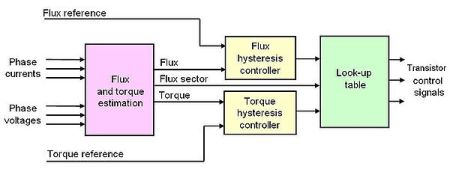
This control method implies the following properties of the control:
- Torque and flux can be changed very fast by changing the references
- The step response has no overshoot
- No coordinate transforms are needed, all calculations are done in stationary coordinate system
- No separate modulator is needed, the hysteresis control defines the switch control signals directly
- There are no PI current controllers. Thus no tuning of the control is required
- The switching frequency of the transistors is not constant. However, by controlling the width of the tolerance bands the average switching frequency can be kept roughly at its reference value. This also keeps the current and torque ripple small. Thus the torque and current ripple are of the same magnitude than with vector controlled drives with the same switching frequency.
- Due to the hysteresis control the switching process is random by nature. Thus there are no peaks in the current spectrum. This further means that the audible noise of the machine is low
- The intermediate DC circuit’s voltage variation is automatically taken into account in the algorithm (in voltage integration). Thus no problems exist due to dc voltage ripple (aliasing) or dc voltage transients
- Synchronization to rotating machine is straightforward due to the fast control; Just make the torque reference zero and start the inverter. The flux will be identified by the first current pulse
- Digital control equipment has to be very fast in order to be able to prevent the flux and torque from deviating far from the tolerance bands. Typically the control algorithm has to be performed with 10 – 30 microseconds or shorter intervals. However, the amount of calculations required is small due to the simplicity of the algorithm
- The current and voltage measuring devices have to be high quality ones without noise and low-pass filtering, because noise and slow response ruins the hysteresis control
- In higher speeds the method is not sensitive to any motor parameters. However, at low speeds the error in stator resistance used in stator flux estimation becomes critical
The direct torque method performs very well even without speed sensors. However, the flux estimation is usually based on the integration of the motor phase voltages. Due to the inevitable errors in the voltage measurement and stator resistance estimate the integrals tend to become erroneous at low speed. Thus it is not possible to control the motor if the output frequency of the variable frequency drive is zero. However, by careful design of the control system it is possible to have the minimum frequency in the range 0.5 Hz to 1 Hz that is enough to make possible to start an induction motor with full torque from a standstill situation. A reversal of the rotation direction is possible too if the speed is passing through the zero range rapidly enough to prevent excessive flux estimate deviation.
If continuous operation at low speeds including zero frequency operation is required, a speed or position sensor can be added to the DTC system. With the sensor high accuracy of the torque and speed control can be maintained in the whole speed range.
The first commercial application was in traction. At the end of 80’s DSC was tried in German diesel-electric locomotives DE502
The first major commercial application was, however, the ACS600 variable speed drive by ABB that saw the daylight in 1995. ACS600 has later been replaced with ACS800.
Motor soft starter
A motor soft starter is a device used with AC electric motors to temporarily reduce the load and torque in the powertrain of the motor during startup. This reduces the mechanical stresson the motor and shaft, as well as the electrodynamic stresses on the attached power cables and electrical distribution network, extending the lifespan of the system.
Motor soft starters can consist of mechanical or electrical devices, or a combination of both. Mechanical soft starters include clutches and several types of couplings using a fluid, magnetic forces, or steel shot to transmit torque, similar to other forms of torque limiter. Electrical soft starters can be any control system that reduces the torque by temporarily reducing the voltage or current input, or a device that temporarily alters how the motor is connected in the electric circuit.
Electrical soft starters can utilize solid state devices to control the current flow and therefore the voltage applied to the motor. They can be connected in series with the line voltage applied to the motor, or can be connected inside the delta (Δ) loop of a delta-connected motor, controlling the voltage applied to each winding. Solid state soft starters can control one or morephases of the voltage applied to the induction motor with the best results achieved by three-phase control. Typically, the voltage is controlled by reverse-parallel-connected silicon-controlled rectifiers (thyristors), but in some circumstances with three-phase control, the control elements can be a reverse-parallel-connected SCR and diode.
Another traditional and the most reliable way to soft start the motor with reduced current is with the help of series reactor. This method is called as series reactor soft starter, which refers to the IEC standard 60289. If an air core is used for designing the series reactor then a very efficient and reliable soft starter can be designed which is suitable for all type of 3 phase induction motor [ synchronous / asynchronous ] ranging from 25 KW 415 V to 30 MW 11 KV. Using an air core series reactor soft starter is very common practice for applications like pump, compressor, fan etc. Usually high starting torque applications do not use this technology for the starting device. A very famous type of such starters are Harmonics free (due to air core) series reactor soft starter.


